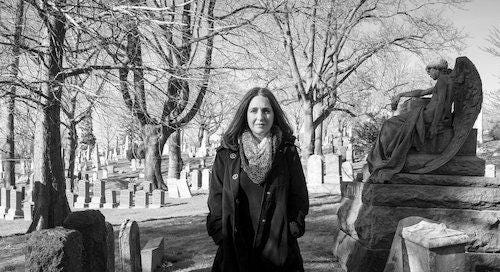Pianist Simone Dinnerstein's latest release, Undersong, is destined to be a classic in the realm of solo piano records. Although Dinnerstein is a classically trained pianist whose interpretations of JS Bach and Beethoven are particularly well-regarded, she has a restless spirit and is inspired by literature, poetry, art, and music that falls well outside the realm of classical. Having crashed the party with a self-financed recording of Bach’s ‘Goldberg’ Variations and a debut performance at New York's Weill Recital Hall that earned a review hailing an “an individual, compelling performance” featuring “a level of coloration beyond the palette Bach knew,” (New York Times, Allan Kozinn, November 2005), Dinnerstein has demonstrated remarkable staying power as both a recording artist and live performer.
Undersong's unifying theme is that of the refrain or chorus, the echo of familiar melodic or harmonic material that the title refers to. The term undersong refers to the underlying meaning, the accompaniment or undertone of a song or other musical work. It's a reference point that allows Dinnerstein to draw from a variety of composers and eras, in the process demonstrating her profound pianistic and interpretive abilities.
Simone opens Undersong with one of two renditions of brief pieces by Francois Couperin, a baroque composer whose pieces are often seen as miniaturized tone poems, and it was this evocative quality that led Richard Strauss to orchestrate some of them. Here Dinnerstein creates a similar transformation to that she performed on the opening "Aria" of the Goldberg Variations. She slows the piece down a great deal from its traditional interpretation, giving it an almost Romantic sheen while at the same time allowing the listener to better grasp Couperin's shifting kaleidoscope of rhythm and harmony. It's an approach that some in the classical world don't appreciate, but as Dinnerstein herself says "I do have a particular way of playing, and if you don’t like it, you don’t like it.”
There is much to like about the way that Dinnerstein handles her program. She follows the Couperin with a Schumann Arabesque, which links strongly with the opening track, creating a sense of the movement from baroque to romantic composers as somewhat inevitable.
Her program takes a sharp turn to the modern with the arrival of Philip Glass' piece "Mad Rush." The piece was written for the organ at the cathedral of St. John the Divine in New York City for the occasion of the Dalai Lama’s first public address in North America in 1979. Dinnerstein is very good at transforming music written for other keyboard instruments such as harpsichord and organ to the piano, transforming the material somewhat as she adapts it to the strengths of the modern piano. She has become a strong interpreter of the music of Philip Glass, with Glass writing his Piano Concerto No. 3 for her in 2017. Dinnerstein recorded three Etudes by Glass, along with Schubert's Sonata in B-flat major, on the album she released in October 2021 entitled A Character of Quiet, also available from Orange Mountain Music.
Following another Couperin piece, 'Tic Toc Choc' and a fairly subdued "Lent," No. 3 of Satie’s ‘3 Gnossienes’, Dinnerstein devotes the second half of her program to ‘Kreisleriana’, a composition in eight movements, composed by Schumann for solo piano. Inspired by a somewhat manic depressive character from the works of E.T.A. Hoffmann named Johannes Kreisler, it is a characteristic Schumann piece that he considered one of his best works, particularly for solo piano. I found this analysis at the website Piano Society to provide some interesting information on the piece. I especially agreed with the idea that "both artists realized the close correlation between the two arts (music and literature). For Hoffmann, the literary powers are stronger and the language is musical, whereas, in Schumann, the musical powers are stronger and the music is literary." (Ronald Taylor, Hoffmann, New York: Hillary House, 1963, 57).
That Simone Dinnerstein is so at home with the most Romantic of German composers suggests that at the center of her playing is a heart that beats Romantic even when she's playing Philip Glass or baroque. Her take on Couperin's "Les Barricades Mysterieuses" is twice as long as the average clock-in on a random sampling of recordings of the piece. Her attention-grabbing "Aria" from 'Goldberg' is more drawn out than that. Dinnerstein could be said to be drawing out the Romantic element from the music, but perhaps by allowing the music to dictate its performance rather than willing it into being Dinnerstein is allowing us to hear what we have not truly heard before: the unfolding of a piece of music as a logical construct that conveys human emotion.
Undersong was recorded from a live stream that Dinnerstein performed on January 8, 2021, and A Character of Quiet was recorded at her home on two consecutive days. Dinnerstein had this to say about the experience of playing for audiences through the medium of streaming and recording from home: “The qualities that I now found most essential to the music were the most quiet, the most nuanced, the most private. Those were the qualities that seemed important as I played for myself in my own room while Adam recorded. I hope that the listener will feel them too.”
Lagniappe
Five solo piano records to hear
Keith Jarrett/Sun Bear Concerts
Paul Bley/Open, To Love
Craig Taborn/Avenging Angel
Art Tatum/Complete Solo Masterpieces
Bill Evans/Solo Sessions (Vol. 1 & 2)



